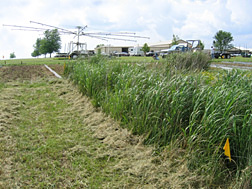ARS-Developed Riparian Zones
Reduce Atrazine Contamination in Water
|
|
Grass filter strips placed in riparian zones not only help curb soil erosion, but they can also help reduce transport and enhance degradation of a popular herbicide, Agricultural Research Service scientists report.
The herbicide atrazine has been used extensively to suppress weeds in corn production for decades. Because it’s now commonly applied to soil without incorporation, it’s especially prone to losses in surface runoff. In 2007, an estimated 36.3 million kilograms of atrazine were applied to more than 66 percent of all U.S. corn acreage.
Recently, contamination of surface water by atrazine and its breakdown components has raised public-health and ecological concerns.
Riparian zones are transitional areas of land between upland areas (for example, crop fields) and water bodies. Grasses and other vegetation in these zones help reduce pollution in streams and lakes. Previous field research has shown that vegetative strips reduce transport of both dissolved and sediment-bound atrazine in surface runoff.
Bob Lerch, a soil scientist in the ARS Cropping Systems and Water Quality Research Unit in Columbia, Missouri, is working with unit colleagues and with Chung-Ho Lin, a University of Missouri assistant professor for forestry, to study the effects of different grass species on herbicide transport and degradation in field and growth-chamber studies.
The study plots are located at the University of Missouri’s Bradford Research and Extension Center. They were originally established in 2000, and the unit took over their maintenance and operation in 2004.
In the growth chamber, the grasses studied were orchardgrass, smooth bromegrass, tall fescue, Illinois bundleflower, ryegrass, switchgrass, and eastern gammagrass. A control treatment with no plants was also included. Plants were allowed to grow for 3 months, to maturity, in a mixture of 60 percent sand and 40 percent Mexico silt loam soil. The rhizosphere soil—that which surrounds roots and is influenced by them—was then separated from the plants and roots. Atrazine was then added to the rhizosphere soil and incubated in the dark for 100 days at 77˚F. Atrazine degradation and mineralization—conversion of atrazine to carbon dioxide—were measured.
Among the plant species, eastern gammagrass showed the highest capacity for promoting atrazine degradation. More than 90 percent of applied atrazine was degraded to less-toxic forms, compared to 24 percent in the control. Rhizosphere soil of orchardgrass, smooth bromegrass, and switchgrass also enhanced atrazine degradation.
The studies have shown that grass buffers reduce herbicide transport to shallow groundwater and in runoff. They do so by trapping sediment and increasing infiltration of water into the soil. The grasses have also significantly enhanced atrazine degradation.
In addition, soil enzymes that have been commonly used for assessing soil quality and microbial activity were shown to be good predictors of atrazine degradation potential in the rhizosphere.
Next, Lerch and Lin plan to introduce a microbe known to completely degrade atrazine. Key challenges with this approach are the microbe’s ability to survive and the stability of its atrazine-degrading genes in the rhizosphere.
“With our new methods, we can track the number of copies of the gene in soil,” said Lerch. “This will tell us how well the genes persisted and whether or not enhanced atrazine degradation is still likely occurring.”—By Alfredo Flores, Agricultural Research Service Information Staff.
This research is part of Soil Resource Management, an ARS national program (#202) described on the World Wide Web at www.nps.ars.usda.gov.
Robert N. Lerch is with the USDA-ARS Cropping Systems and Water Quality Research Unit, 269 Agricultural Engineering Building, 1406 Rollins St., Columbia, MO 65211; phone (573) 882-9478, fax (573) 882-1115.
"ARS-Developed Riparian Zones Reduce Atrazine Contamination in Water" was published in the January 2009 issue of Agricultural Research magazine.







